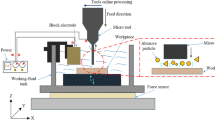Abstract
Chip formation control is an important problem in unmanned machining operations. Short, discontinuous chips are often most desirable to avoid entanglement with tooling and to aid with mechanized removal systems. Chip formation conditions can change during machining, especially with single-point turning. Experiments were conducted on a machining center. Conditions of feedrate-induced segmented chips correlate well with the count rate of acoustic emission (AE). The sensitivity of AE signals to chip congestion or entangling due to continuous chip formation is illustrated.
Similar content being viewed by others
References
K. Nakayama and M. Ogawa: “Basic Rules on the Form of Chip in Metal Cutting,”Annals CIRP, vol. 27, no. 1, pp. 17–21, 1978.
“Automatic Detection of Chip Breaking,” review of article fromIndustrie-Anzieger, July 1979, vol. 101, p. 59.
W. Kluft, W. Konig, C. A. van Luttervelt, K. Nakayama, and A.J. Pekelharing: “Present Knowledge of Chip Control,”Annals CIRP, 1979, vol. 28, no. 2, pp. 441–55.
D. Dornfeld and M.S. Lan: “Chip Form Detection Using Acoustic Emission,” Proceedings of the 11th NAMRC, SME, University of Wisconsin, Madison, WI, May 1983, pp. 386–89.
E. Kannatey-Asibu, Jr. and D. A. Dornfeld: “Quantitative Relationships for Acoustic Emission from Orthogonal Metal Cutting,”Trans. ASME, J. Eng. Ind., 1981, vol. 103, no. 3, pp. 330–40.
M.S. Lan and D.A. Dornfeld: “Experimental Studies of Tool Wearvia Acoustic Emission Analysis,” Proceedings of the 10th NAMRC, SME, McMaster University, Hamilton, Ontario, May 1982, pp. 305–11.
N. H. Cook, I. Finnie, and M. C. Shaw: “Discontinuous Chip Formation,”Trans. ASME, February 1954, vol. 76, pp. 153–62.
S. Kaldor, A. Ber, and E. Lenz: “On the Mechanisms of Chip Breaking,” ASME Paper No. 78-WA/PROD-21, 1978.
C. Spaans: “Break Mechanism in Cutting with a Chip Breaker,”Annals CIRP, 1970, vol. 18, p. 87.
N. H. Cook:Manufacturing Analysis, p. 58, Addison-Wesley, Reading, MA, 1966.
H. E. Enahoro and P. L. B. Oxley: “An Investigation of the Transition from a Continuous to a Discontinuous Chip in Orthogonal Machining,”Int. J. Mech. Sci., 1961, vol. 3, p. 149–50.
D.A. Dornfeld: “Investigation of Machining and Cutting Tool Wear and Chatter Using Acoustic Emission,”Review of Progress in Quantitative NDE, pp. 475–83, Plenum Press, NY, 1981.
Author information
Authors and Affiliations
Rights and permissions
About this article
Cite this article
Dornfeld, D.A., Pan, CS. A study of continuous/discontinuous chip formation using acoustic emission. J. Applied Metalworking 4, 18–29 (1985). https://doi.org/10.1007/BF02833673
Issue Date:
DOI: https://doi.org/10.1007/BF02833673



